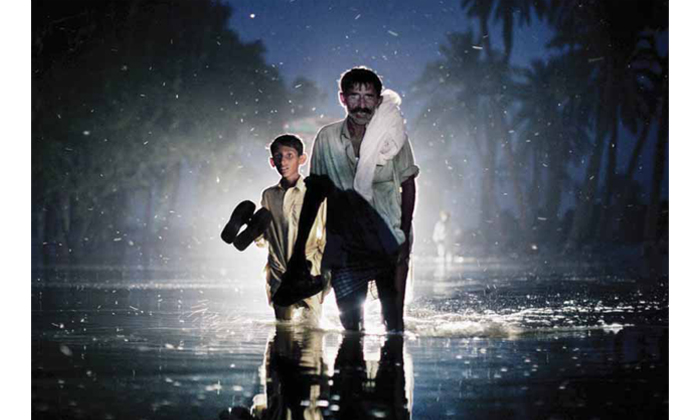A natural disaster cycle is afflicting Pakistan, the flooding of Sindh is only one such incident. With thousands homeless and suffering, the under funded ‘National Disaster Management Authority’ and unprepared provincial governments are unable to cope, due to political and societal fissures in the system, that is already heavily burdened by defence spending. Raza Rumi analyses the situation of the Pakistan Floods.
“The silver lining is that, there are committed civil society organizations across Pakistan, which have been active in working with the affected population.”
Pakistan’s southern province of Sindh has suffered another natural disaster this year. The 2010 floods wreaked havoc in the province and the victims had barely regained their lives and livelihoods, before the August 2011 natural disaster hit the province again. This years floods unlike the 2010 calamity were somewhat restricted as they inundated districts of the Sindh province. The floods started after a round of monsoon rains in areas of Sindh, southern Punjab and eastern Baluchistan. Within a month or so, nearly nine million people were displaced and there were more than 400 recorded fatalities to date.
The most affected district in the Sindh province remains Badin but other rural areas also face a catastrophic situation. Crops on 6.6 million acres of land have been completely destroyed and over a million and a half houses have been washed away. Over a hundred thousand livestock – the major source of income for the poor – have been lost. Overall economic losses are still being estimated but they might be in billions of dollars.
Such is the nature of Pakistan’s political instability that an elected government, in theory responsive to its voters had undertaken little planning or preparation. The ‘National Disaster Management Authority’ (NDMA) after the mega floods of 2010 underwent a resource crunch and a change of leadership. The provincial government has been more worried about keeping the urban Sindh and its large party ‘Muttahida Qaumi Movement’ (MQM) pacified and a collation partner thereby neglecting the essential task of preparing for disasters and providing swift relief. Even this year the Met offices had predicted the intensity of monsoon but the authorities paid no heed to these advanced warnings.
Several experts have cited climate change as one of the key reasons for these weather cycles and repeated flooding. However, at the policy level, despite the international commitments, climate change has yet to appear as a priority. In a reactive mode, the federal and provincial governments have been dealing with the post-floods situation. Unfortunately, given Pakistan’s image problem or the singular focus on terrorism, the international community has not been too forthcoming with respect to requests of aid; and the Government of Pakistan due to its heavy expenditure on defence and short term commitments is short of money. ‘The United Nations Floods 2011 Rapid Response Plan’ has only been able to gather $66 million (18 per cent) against its appeal of $357 million, without any significant pledges or commitments in the pipeline. The challenge, as before, is the outbreak of disease and taking care of thousands of pregnant women and their children who are vulnerable to this calamity.
What makes the tasks of rescue/relief and early recovery difficult to impossible is the absence of elected local governments that can oversee relief efforts. Three years since democracy returned to Pakistan, the local government system awaits the attention of the political governments. Similarly, Pakistan’s provinces have been constitutionally empowered with the trimming of federal government and its tasks via the 18th Amendment. However, the capacities of the provinces to undertake more functions and responsibilities remain limited. The provincial ‘Disaster Management Authority’ was also under-funded and under staffed before the second disaster hit Sindh within a span of thirteen months.
The silver lining is that, there are committed civil society organizations across Pakistan, which have been active in working with the affected population. Youth and citizen groups have been raising money and making frequent visits to the area. For example, ‘Sarelief’ – a relief organization – has been running a kitchen feeding thousands of people daily for the past few weeks. They and many other groups have organized dozens of medical camps, distributed safe drinking water bottles, juice packets and thousands of ration hampers. Islamists have also been active there. Scores of other organisations are busy, helping the flood victims but floods, as many experts have told, will continue to affect Pakistan in the future.
Pakistan not unlike other South Asian countries will undergo several shocks and changes given that climate change is a global and incontrovertible phenomena. Communities in the villages, on coastal areas have to be prepared to adapt to the new realities and there is much to be done; across every sector by the state, civil society and the community groups. A good example that comes to mind is Bangladesh, which has coped well with the vagaries of weather patterns and has set some good practices. For instance, in many parts of Bangladesh along the coastline, houses are being constructed in a manner that protects them from flooding. Climate change has also entered the educational curricula and more and more awareness is being imparted as to how people can survive.
Scientists have already predicted increase in frequency and intensity of extreme weather events like droughts and floods. Given the massive population in the region, the future forecasts are worrying. Rainfall data for India reveal the increase in the frequency of severe rainstorms over the last fifty years. A UN report says, “The number of storms with more than 100 mm rainfall in a day is reported to have increased by 10 percent per decade.” At the same time, drought is also a reality that many parts of India and Pakistan have experienced in the recent years. Water scarcity is already alarming and forecasts tell us that in South Asia, 2.5 billion people will be impacted by“water stress” and scarcity by the year 2050.
Our greatest misfortune in this information age is that South Asian neighbours are not learning from each other and not talking (enough) with each other. Petty disputes and political shenanigans override the need for informed partnership, cooperation and collaboration in policy sphere. Whether they like it or not, the aggressive nation states of India, Pakistan and Bangladesh have common environmental challenges and the weather systems give no importance to man-made borders guarded by armies. Sooner than later, they will have to find a common agenda for the way forward.
As Stephen Cohen says, South Asia “is not merely a geographical name-place, it is a region tied together by climate, environment, strategy, social structure and military engagement”; and adds that “Pakistan and India share a common ecology, including a Himalayan water source that also shapes the identities of Nepal and Bangladesh; as global climate change proceeds apace, this will have profound and probably disturbing consequences for the entire region unless carefully managed.”
About time natural disasters are also viewed beyond the lens of nation-states and regional perspectives














